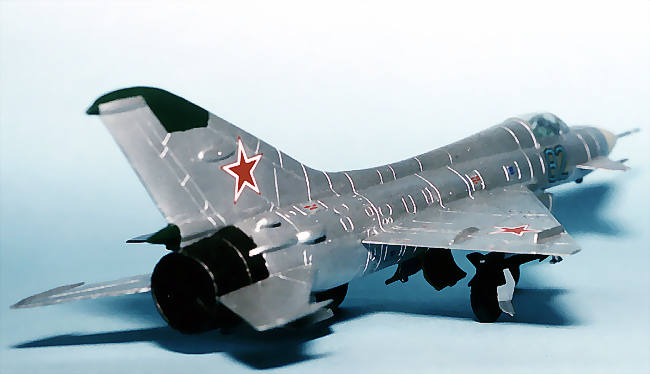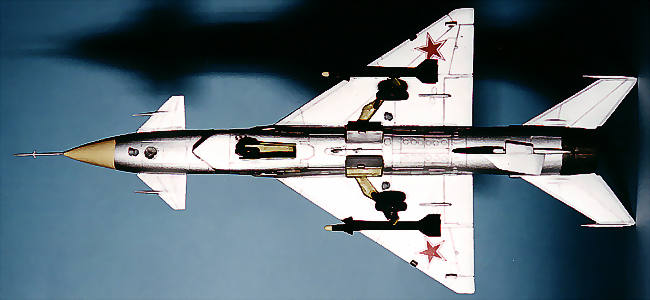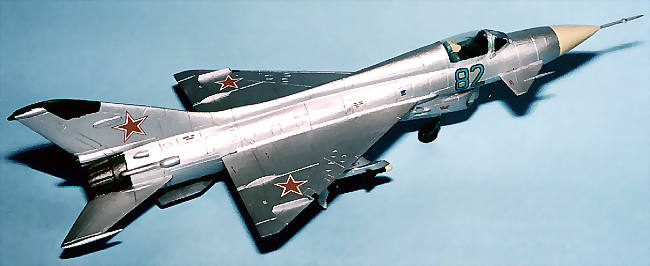|
E-8/2
by Konrad Kondrat
|
 |
|
E-8/2 |
images and translation by
Wojciech Perkowski

HyperScale is proudly supported by
Squadron.com
The Soviet E-8 is not only one of the most original experimental
planes based on the MiG-21 but one of the most mysterious too. There
are discrepancies in Soviet and Russian sources even nowadays.
Nevertheless the fact is some construction solutions were used
in next O.K.B. MiG fighters (starting from MiG-21 PFM and even till
MiG-29).
Work on new version of MiG-21 was started in 1960. The intention
was to significantly improve maneuverability, speed and equipment
including new long range radar. Front horizontal stabilisers were
earlier tested on E-6T3 plane.
According to O.K.B. MiG sources, the E-8 was born “as usual”
from rebuilt MiG-21 PF. Meanwhile the construction team led by N.
Mietzkharishvili called the prototype the MiG-23.
In fact only wings and rear horizontal stabilisers resembled the
MiG-21 PF. All the rest looked new.

The prototype of the new R-21F-300 engine (developed later into
R-27F-2M300 and used in MiG-23) was also used. Minor additions like
a parachute container in the vertical stabiliser root and new KM-1
ejection seat were utilised in the next, serial produced Mig-21 PFM.
A retractable (towards right) stabiliser similar to MiG-23 one was
mounted under the rear fuselage . The most distinctive
characteristic of the E-8 was an under-fuselage air intake with a
wedge (incorporating the front undercarriage bay) adjustable in 3
steps.
The first E-8/1 prototype started test flights in 1962. The
well-known test pilot - G. Masolov - flew the aircraft until a
tragic accident in Autumn 1962, when the engine choked at 8000 m. at
supersonic speed while in “upside-down” flight. Masolov was badly
injured one leg and shoulder while ejecting. Additional injuries
were incurred from the parachute landing. Masolov survived but his
career as a test pilot was over.
The second prototype E-8/2 was to be armed with R-3S rockets and
Shafir – 21 radar. But in fact it used to fly only with dummy
rockets and weight equivalent for new radar. Test flights were
executed by known pilot too – A. Fiedotov, but for short time, as
E-8 program was suddenly abandoned in 1963 for unknown reasons.

It’s worth noticing that in spite of frequent engine choking,
the ventral air intake conception was obstinately kept. Some light
on this situation cab be thrown on this attitude when, in 1962 other
O.K.B. MiG team led by R. A. Bielakov started works with
construction later called officially MiG-23. All initial projects
used side air intakes. So, it’s difficult to state whether E-8 was
only experimental plane or alternative new MiG prototype. It’s worth
noting, though, that R. A. Bielakov was also the leading constructor
of MiG-29 which has belly air intakes.
Only photos and drawings (1) left after E-8. E-8/2 was probably
wrecked.
My 1/72 model was almost scratchbuilt. There is vacuform kit by
Frank-Modelbau (earlier Airmodel) but it’s silhouette isn’t even
close to real E-8.
The kit is only “almost”scratchbuilt, as Bilek MiG-21PFM wings
and rear stabilisers were able to be used. The main undercarriage is
from this kit too. I decided to make my E-8/2 model armed.
Pylons, were taken from the Academy MiG-23S. Also reshaped belly
stabiliser and fuselage nose came from that kit. Fortunately
Academy’s MiG-23S nose is in fact ML version (not S as the box
states) and is suitable for E-8.
Creating the front fuselage was rather challenging. Tons of
putty, styrene pieces and other materials were used. Especially
difficult was the air intake. It’s cross-section is hexagonal, close
to rectangular and I am not happy with my final result here. However
the wedge inside intake and wedge separating boundary layer between
intake and fuselage was quite successful.

Minor scratchbuilt details include the front undercarriage,
landing light, camera window, air outlet covers on intake sides,
telemetric antenna between main undercarriage doors. Also
scratchbuilt are the front horizontal stabilisers and rear fuselage
air intakes including these characteristic ones joined with exhaust
nozzle actuators. Unfortunately the exhaust nozzle was scratchbuilt
too.
The whole fuselage was rescribed, and the wings needed some
improvement including control surfaces actuators fairings in
non-standard way located on wing upper surfaces.
Bilek’s MiG-21PFM cockpit was utilised, KM-1 ejection seat. The
cockpit was painted with Agama C35M Russian Modern Interior.
Vertical stabiliser’s top and fuselage top required some
improvements.
A new canopy was quasi - vacuformed.
My E-8/2 was painted with
-
Revell 91 Aluminium (overall
airframe),
-
nose and rocket warheads - Revell 314
Beige,
-
green dielectric surfaces, parachute
container, wheel discs - Humbrol 30,
-
tires - Humbrol 32.
My own various paints mixes were used for exhaust nozzle, black
- green rockets body and chromate yellow undercarriage bays.

Decals – stars and stencils seen on photos came from my spare
box. The blue 8 from tactical number is for E-8 and the 2 means
second prototype.
The whole model was sprayed with Humbrol Satin Cote.
Click the thumbnails
below to view larger images:
Model and Original Text Copyright © 2002 by
Konrad Kondrat
Images and
Translation Copyright © 2002 by
Wojciech Perkowski
Page
Created 19 December, 2002
Last updated
04 June, 2007
Back to HyperScale Main
Page
Back to Reviews
Page
|
Home
| What's New |
Features |
Gallery |
Reviews |
Reference |
Forum |
Search